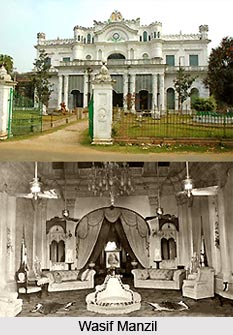 Wasif Manzil Palace is one of the well decorated palaces in West Bengal. This palace was built by Nawab Wasif Ali Mirza Khan under the direction and supervision of Mr. Vivian, officer of the Public Works Department of the Nadia Rivers Division and Surendra Barat, a Bengali engineer of that time.
Wasif Manzil Palace is one of the well decorated palaces in West Bengal. This palace was built by Nawab Wasif Ali Mirza Khan under the direction and supervision of Mr. Vivian, officer of the Public Works Department of the Nadia Rivers Division and Surendra Barat, a Bengali engineer of that time.
Wasif Manzil Palace initially was used by the Nawab Of Bengal as his residence. The building is extremely close to the Hazarduari Palace in Murshidabad District. It is built on the Nizamat Fort Campus between the campus`s Dakshin Darwaza or South Gate and the Hazarduari Palace, just opposite the campus`s South Zurud Mosque and parallel to the Bhagirathi-Hugli Rivers.
Wasif Manzil Palace was extensively destroyed in the earthquake on 12 June 1897. The whole of the palace`s second storey came down within a few seconds. It was repaired later but without the second storey. Adjacent to the palace was an artificial hill and a landscape garden which now cease to exist.
Wasif Manzil Palace has been designed to look a little like a castle with small corner turrets on the corners. Wasif Manzil Palace has a semi-circular pediment with the Nawabs of Murshidabad `s coat of arms on it. Now, the palace is maintained by the Archaeological Survey of India and has been transformed into a museum. The palace has a garden space in front of it which has a fountain and several marble statues.
The garden space near Wasif Manzil Palace is enclosed with a handsome iron railing. The main entrance is a Norman archway with open-work iron doors. The staircases and statues inside the Wasif Manzil Palace are also made of marble, which are worth seeing among the domestic and international tourists.
This article is a stub. You can enrich by adding more information to it. Send your Write Up to content@indianetzone.com



















